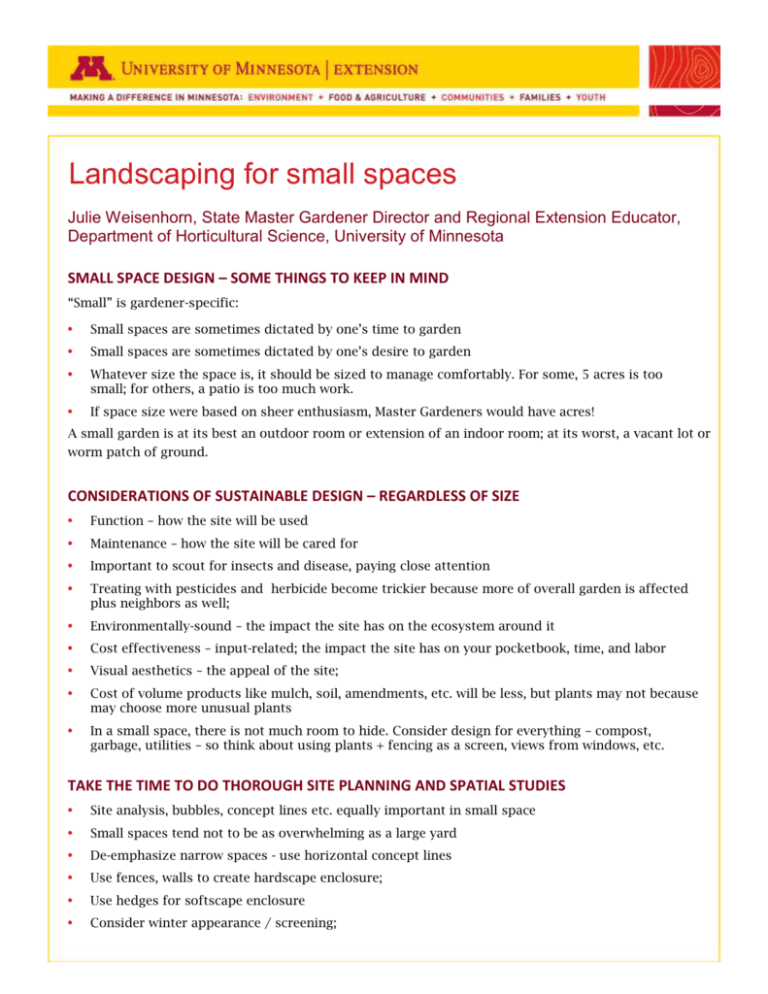
Landscaping for small spaces
Julie Weisenhorn, State Master Gardener Director and Regional Extension Educator,
Department of Horticultural Science, University of Minnesota
SMALL SPACE DESIGN – SOME THINGS TO KEEP IN MIND
“Small” is gardener-specific:
•
Small spaces are sometimes dictated by one’s time to garden
•
Small spaces are sometimes dictated by one’s desire to garden
•
Whatever size the space is, it should be sized to manage comfortably. For some, 5 acres is too
small; for others, a patio is too much work.
•
If space size were based on sheer enthusiasm, Master Gardeners would have acres!
A small garden is at its best an outdoor room or extension of an indoor room; at its worst, a vacant lot or
worm patch of ground.
CONSIDERATIONS OF SUSTAINABLE DESIGN – REGARDLESS OF SIZE
•
Function – how the site will be used
•
Maintenance – how the site will be cared for
•
Important to scout for insects and disease, paying close attention
•
Treating with pesticides and herbicide become trickier because more of overall garden is affected
plus neighbors as well;
•
Environmentally-sound – the impact the site has on the ecosystem around it
•
Cost effectiveness – input-related; the impact the site has on your pocketbook, time, and labor
•
Visual aesthetics – the appeal of the site;
•
Cost of volume products like mulch, soil, amendments, etc. will be less, but plants may not because
may choose more unusual plants
•
In a small space, there is not much room to hide. Consider design for everything – compost,
garbage, utilities – so think about using plants + fencing as a screen, views from windows, etc.
TAKE THE TIME TO DO THOROUGH SITE PLANNING AND SPATIAL STUDIES
•
Site analysis, bubbles, concept lines etc. equally important in small space
•
Small spaces tend not to be as overwhelming as a large yard
•
De-emphasize narrow spaces - use horizontal concept lines
•
Use fences, walls to create hardscape enclosure;
•
Use hedges for softscape enclosure
©•2010,Consider
Regents of the
University
of Minnesota. /
Allscreening;
rights reserved. University of Minnesota Extension is an equal opportunity educator and
winter
appearance
employer. This material is available in alternative formats upon request. Direct requests for consultation on formats to 800-876-8636.
Printed on
recycled and recyclable paper with at least 10 percent postconsumer waste material. 12/10
PLANT SELECTION
•
Plant size is critical in all landscapes, large or small
•
Large plants in small spaces for canopy
•
Form becomes more pronounced in smaller spaces because there are fewer plants;
•
Consider selecting plant materials with persistent fruit or fruit you pick, or sterile plants to avoid
heavy seeding. This will save time and the mess of fruit and seeds covering a small area;
•
Use small plants in mass to feature path ways - creeping thyme, small sedum, woodland phlox,
Galium;
•
Poor plant health becomes more evident in a small space;
PLANTS AND STRUCTURES CAN DO DOUBLE DUTY
•
Rocks and Walls = seating
•
Arbors, trellises, etc. = shade, privacy
•
Plants with airy inflorescences = screen / scrims
(Northern Gardener)
•
Bird bath + water feature
•
Choose plants that can be both accent and
specimen throughout year
•
Interplant with vegs and fruits; can place
containers into garden beds
•
Potager garden = vegs and herb garden
•
Interplant between step stones
•
Incorporate just 1-3 focal points in a small space
BORROW VIEWS
•
Extensional landscapes – neighbors, city skyline,
natural view, etc. – are key from inside out and
outside in.
•
Borrow views
•
Plants viewed close-up - Small space and closeup view – adds detail - Detail close up, but
everything is close up
•
Backdrops
© 2011 Regents of the University of Minnesota. All rights reserved. University of Minnesota Extension is an equal opportunity educator and employer. In
accordance with the Americans with Disabilities Act, this material is available in alternative formats upon request. Direct requests to the Extension Store at
800-876-8636.
Printed on recycled and recyclable paper with at least 10 percent postconsumer waste material.
REMEMBER THE PRINCIPLES OF DESIGN: UNITY, SIMPLICITY, VARIETY, EMPHASIS, SCALE,
SEQUENCE, BALANCE
•
Simplicity & variety
o
•
•
Keep variety to a minimum and use small plants in combinations placed in areas viewed up
close and personal;
Unity: Repetition
o
Masses
o
color - White, silver, cream makes area look larger
o
materials – texture - Materials should fit home and style
o
avoid start-stop open areas between plants
Scale - Maintain scale between plants, hardscape and the space overall;
GO VERTICAL
•
Espalier, topiaries, trellising, pleaching
•
Raised beds, planting areas, containers
•
Use dwarf and columnar forms
TURF AREAS
Consider maintenance and whether turf is the best choice
•
Radii of concept lines – mowing, repeated mowing in area
•
Need for a weed whip? Not if designed properly.
•
Wearing on area by mowing repeatedly
SOME SMALL SPACE DESIGN RESOURCES
•
Rice, Graham. The Ultimate Book of Small Gardens
•
Messervy, Julie Moir and Susanka, Susan. Outside the Not So Big House
•
Beaulieu, David. “Color Theory in Landscape Design”,
http://landscaping.about.com/od/flowersherbsgroundcover1/a/flower_photos.htm
•
Luss, Gunda. “Color Techniques for Landscape Design”
http://www.sustland.umn.edu/design/colortechniques.html
•
Boulden, Steve. “Big Help for Small Gardens”, http://www.the-landscape-designsite.com/smallgardens.html
© 2011 Regents of the University of Minnesota. All rights reserved. University of Minnesota Extension is an equal opportunity educator and employer. In
accordance with the Americans with Disabilities Act, this material is available in alternative formats upon request. Direct requests to the Extension Store at
800-876-8636.
Printed on recycled and recyclable paper with at least 10 percent postconsumer waste material.








